Marcia Thornton Jones's Blog, page 94
September 8, 2019
Speaking to Kids --- by Jane Kelley
I was a performer before I became a writer. I enjoy standing in front of people and acting the part of the professional, charming, witty novelist. I don't even worry that technology will once again refuse to be my friend.

Here I am, right before giving a speech at my library. I'm smiling, despite the knowledge that I can't show the amazing power point I spent days preparing. The library's projector, for reasons only it understands, refuses to speak to my laptop.
That's okay! No one really needed to see those photos. Pictures of Blackberry are always crowd-pleasers, but I managed fine without them.
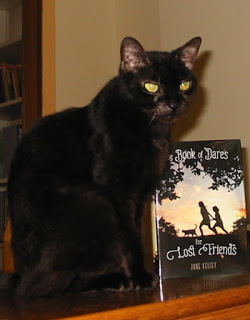
I must confess that I am anxious about something when I speak.
It's impossible to predict what kids will ask.
That's why we love them. Their thinking has not been constrained. They are not polite. They are not filtered. They don't know that it isn't good manners to ask someone how old she is. Or how much money she makes. Or if any of her books are bestsellers.
I've learned the hard way to be ready to answer these questions. (I'm old. Not much money. Once my book was a best seller in a particular book store. And even on Amazon, if the category is narrow enough. Nature Girl is #1 among all books written by people named Jane Kelley!)
I gladly accept those tough questions, because kids have also asked me other unfiltered things that I was happy to have the opportunity to ponder.
What do you do when a book gets rejected?
What's your least favorite part about writing a story?
And, perhaps most poignant of all, are you ever lonely?
Yes, dear reader, sometimes I am.
There was one question that totally stumped me. At an appearance in Brooklyn, a boy held up a copy of Octo-Man and the Headless Monster.
"Did you really write this book?" he said.
"Yes," I said, blushing slightly, still feeling delighted that something I had created was out in the world.
"Then what's the first word on page 53?"
I couldn't answer that--not even after he gave me a hint. "It starts with the letter G."

Here I am, right before giving a speech at my library. I'm smiling, despite the knowledge that I can't show the amazing power point I spent days preparing. The library's projector, for reasons only it understands, refuses to speak to my laptop.
That's okay! No one really needed to see those photos. Pictures of Blackberry are always crowd-pleasers, but I managed fine without them.

I must confess that I am anxious about something when I speak.
It's impossible to predict what kids will ask.
That's why we love them. Their thinking has not been constrained. They are not polite. They are not filtered. They don't know that it isn't good manners to ask someone how old she is. Or how much money she makes. Or if any of her books are bestsellers.
I've learned the hard way to be ready to answer these questions. (I'm old. Not much money. Once my book was a best seller in a particular book store. And even on Amazon, if the category is narrow enough. Nature Girl is #1 among all books written by people named Jane Kelley!)
I gladly accept those tough questions, because kids have also asked me other unfiltered things that I was happy to have the opportunity to ponder.
What do you do when a book gets rejected?
What's your least favorite part about writing a story?
And, perhaps most poignant of all, are you ever lonely?
Yes, dear reader, sometimes I am.
There was one question that totally stumped me. At an appearance in Brooklyn, a boy held up a copy of Octo-Man and the Headless Monster.
"Did you really write this book?" he said.
"Yes," I said, blushing slightly, still feeling delighted that something I had created was out in the world.
"Then what's the first word on page 53?"
I couldn't answer that--not even after he gave me a hint. "It starts with the letter G."
Published on September 08, 2019 06:00
September 3, 2019
Because Good Manners Can Change the World
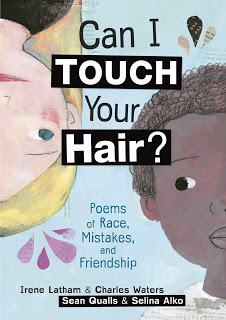 Happy Kids Good Manners Month!
Happy Kids Good Manners Month!When CharlesWaters and I created the words for CAN I TOUCH YOUR HAIR? Poems of Race, Mistakes and Friendship, we had no idea that we would eventually collaborate on other books as well. Next up, an ambitious middle grade difficult-to-categorize book: DICTIONARY FOR A BETTER WORLD: Poems, Quotes and Anecdotes from A to Z coming February 4, 2020, from Lerner, with illustrations by Mehrdokht Amini. The heart of this book is a list of words – like ally, compassion, empathy, zest – that we think can help us all make improvements to ourselves and to our spaces.What Charles and I discovered, and what kept coming back to us while we wrote and revised this book, was how the most basic thing anyone can do to improve the world is to use good manners. Be polite, respectful. Say thank you. It's that simple. One of the entries in our DICTIONARY is “Netiquette,” because where else in the world do we see people of all ages NOT using good manners? Where do things so easily go terribly wrong? Yep, on ye ol' internet.
We are so excited to deliver this book to the world... and wow, wait until you see the art... A-MA-ZING! For those of you who will be at NCTE, Lerner will be offering free copies, and we will be signing... hope to see you there!--------------Irene Latham lives on a lake in rural Alabama where she tries to live her poem each and every day. She is the author of a wide variety of books for kids, including fiction and nonfiction picture books, poetry and novels.
Published on September 03, 2019 03:30
August 29, 2019
By Charlotte BennardoWhen setting a story in a location w...
By Charlotte Bennardo
When setting a story in a location we are not very familiar with, the best thing would be to go to that place to absorb the culture, take note of the architecture, listen to the language, and talk to the populace.
Ah, if only.
My co-authored YA novel, Blonde OPS, takes place in Italy. Rome, to be exact. I have never been to Rome, and neither had my co-author. (It's on the bucket list.) So even if I browsed through travelogues, I'd only get a smattering of the information I needed. And, the publisher would have laughed hysterically if we suggested a 'working' trip to Rome. So actually going to Rome was not an option.
Many authors are faced with this dilemma. Sure, you can ask around, see if someone has been there, knows things about the place, but it's not the same as being there. Human memory isn't the best; it is selective, and discards things it doesn't deem important enough to remember although as many criminal trials have proven, it's the little details that can make or break a case/story.
Thankfully, by starting with a travelogue, we could pick out landmarks we wanted to use in our story. Complete histories, addresses, guided tour information, and even a picture gave us a good start. But, a picture is flat. How could we walk down a cobbled street to see a small cafe, with basil pots in the windows, and hidden alcoves with weathered statues?
By traveling with Google Earth. When I give workshops and presentations on research tools for writers, Google Earth is one of my favorites. In Blonde OPS, there are car chases, sightseeing on a scooter, a romantic walk through the back streets, and ancient hidden staircases. By putting in an address, Google Earth lets you 'walk' down the street via GPS in virtual reality. I saw the blooming spice pots. I saw the uneven stone cobbles. I saw twisty, narrow streets. A fan who read the book said she felt like she was actually in Rome, meandering the streets, or standing in the Vatican's St. Peter's Square. Others, who've actually been to Rome, have said, "I know that place!" Even though we made up hotel names where spy action/kidnappings/etc. take place, the main thoroughfares exist. I spent so much time 'traveling' with Google Earth, it sometimes felt like I'd been there. And that's when you know you've nailed it.

If you want to get a feel for a place before traveling, or when you can't travel, book your ticket via Google Earth, and let your mouse guide you.
When setting a story in a location we are not very familiar with, the best thing would be to go to that place to absorb the culture, take note of the architecture, listen to the language, and talk to the populace.
Ah, if only.
My co-authored YA novel, Blonde OPS, takes place in Italy. Rome, to be exact. I have never been to Rome, and neither had my co-author. (It's on the bucket list.) So even if I browsed through travelogues, I'd only get a smattering of the information I needed. And, the publisher would have laughed hysterically if we suggested a 'working' trip to Rome. So actually going to Rome was not an option.
Many authors are faced with this dilemma. Sure, you can ask around, see if someone has been there, knows things about the place, but it's not the same as being there. Human memory isn't the best; it is selective, and discards things it doesn't deem important enough to remember although as many criminal trials have proven, it's the little details that can make or break a case/story.
Thankfully, by starting with a travelogue, we could pick out landmarks we wanted to use in our story. Complete histories, addresses, guided tour information, and even a picture gave us a good start. But, a picture is flat. How could we walk down a cobbled street to see a small cafe, with basil pots in the windows, and hidden alcoves with weathered statues?
By traveling with Google Earth. When I give workshops and presentations on research tools for writers, Google Earth is one of my favorites. In Blonde OPS, there are car chases, sightseeing on a scooter, a romantic walk through the back streets, and ancient hidden staircases. By putting in an address, Google Earth lets you 'walk' down the street via GPS in virtual reality. I saw the blooming spice pots. I saw the uneven stone cobbles. I saw twisty, narrow streets. A fan who read the book said she felt like she was actually in Rome, meandering the streets, or standing in the Vatican's St. Peter's Square. Others, who've actually been to Rome, have said, "I know that place!" Even though we made up hotel names where spy action/kidnappings/etc. take place, the main thoroughfares exist. I spent so much time 'traveling' with Google Earth, it sometimes felt like I'd been there. And that's when you know you've nailed it.

If you want to get a feel for a place before traveling, or when you can't travel, book your ticket via Google Earth, and let your mouse guide you.
Published on August 29, 2019 06:00
August 27, 2019
Welcome Back to Villa Villekulla!
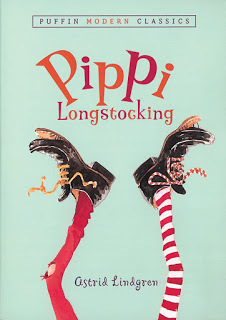
I've embarked on a bold experiment as of late: I'm re-reading some classic children's chapter books that I loved when I was younger.
It's a little scary because there's a chance that I won't love these books on this go-round and that my memories of cherished stories will be forever tainted. I just finished one the other day that didn't thrill me like it did when I was a child. The protagonist's misadventures were so predictable to my adult mind, and I couldn't help but notice all the things that were perfectly acceptable in a 1950s-era book that just wouldn't fly today. So I was a little hesitant to re-read my beloved Pippi Longstocking for fear that it might tarnish my childhood memories.
But guess what? It holds up!
I tried to analyze why. Astrid Lindgren doesn't use any type of super-fancy narrative techniques, after all. Chapter one doesn't begin with a catchy hook or dialogue; the first couple of paragraphs are straight-up exposition. But here's the thing: when you have a crazy-fun character like Pippi Longstocking who lives in a house like Villa Villekulla all by herself, with a suitcase full of gold from her cannibal king father, and a horse in the kitchen, and a sidekick monkey, there's pretty much no way you can go wrong in telling the story. With such an irresistible setting and main character, the story almost begs to tell itself.
I absolutely loved Pippi when I was a little girl, and I desperately wished I could live next door to her like Tommy and Annika did and have all sorts of kooky adventures at Villa Villekulla.
I was afraid to try to go back to Villa Villekulla as a grown-up, but I'm so glad I did, because in doing so, my childhood wonder was reborn.
Now if you'll excuse me, I'm off to go back to being a Thing-Finder with my friends Pippi, Tommy, and Annika.
Ginger Rue is the author of the Aleca Zamm series from Aladdin and the Tig Ripley series from Sleeping Bear.
Published on August 27, 2019 22:00
August 25, 2019
Travels Big and Small (Holly Schindler)
Traditionally, each main character in a story undergoes a pretty radical change—of heart, mind, or both. It’s an internal journey. The external journey that the main character goes on (solving a mystery, saving the planet—or maybe a baby brother, etc.) allows for the internal journey and change to take place.
But one of the most enjoyable parts about writing MG is how truly small the external journeys can be—especially when writing realism. And showing what an immense internal change those tiny physical journeys can make.
Characters of this age aren’t exactly going to put themselves on planes. Jump continents. If they travel much farther than their own neighborhood, you’ll start to hear readers grumbling about your storyline being implausible.
Think about that: their external journey will most likely take place in just a few blocks. It will involve a handful of locations—school, home, maybe a friend’s house.
And in that small slice of a physical location, they can take the kind of internal journey that means their lives are different. They’ve changed their entire outlook. They believe in themselves in a new way.
Really, though—adult life isn’t quite so different. We have the ability and means to move greater distances, but what really changes us—experiences far from home, or close to it? Strangers or those we’ve come to rely on in our day-to-day lives?
As a writer of books for all ages, I’m constantly surprised how writing in one genre informs another. And this lesson from the MG world—about a character's small inner circle—consistently helps shape work I write for older readers.
What’s your own favorite story in which the plot unfolds in a tight space?
Published on August 25, 2019 00:00
August 22, 2019
Character as a Complexity of Images: Smack Dab in the Imagination by Dia Calhoun
Like every writer, I use my imagination to bring characters to life, flesh them out, animate them. But I never considered how images are related to that process until I read these words by archetypal psychologist James Hillman:
"If the character of a person is a complexity of images, then to know you I must imagine you, absorb your images. To stay connected with you, I must stay imaginatively interested, not in the process of our relationship or in my feelings for you, but in my imaginings of you. The connection through imagination yields an extraordinary closeness. Where imagination focuses intently on the character of the other . . . love follows.” —The Force of Character p185
Hillman wasn't writing about creating fictional characters, but certainly could have been. Because yes. Writers do love—with all the complexity of love—their characters. This quote also gives a clue to why readers often feel more connected to a book character than a living person. “The connection through imagination yields an extraordinary closeness.”
To look at your characters in a new way, try to consider them as a "complexity of images." Also, if you're having trouble developing one of your characters, consider this from the next page:
“Relationships fail not because we first stop loving but because we first stop imagining.” p186
Hillman's ideas also speak to the current cultural crises of immigration and gun violence. Failure to connect with the unknown other is a failure of imagination. No imagination equals no love or empathy. Abominations follow.
Not only does The Force of Character offer insights into imagination and character, but the prose is gorgeous. I highly recommend it.
"If the character of a person is a complexity of images, then to know you I must imagine you, absorb your images. To stay connected with you, I must stay imaginatively interested, not in the process of our relationship or in my feelings for you, but in my imaginings of you. The connection through imagination yields an extraordinary closeness. Where imagination focuses intently on the character of the other . . . love follows.” —The Force of Character p185
Hillman wasn't writing about creating fictional characters, but certainly could have been. Because yes. Writers do love—with all the complexity of love—their characters. This quote also gives a clue to why readers often feel more connected to a book character than a living person. “The connection through imagination yields an extraordinary closeness.”
To look at your characters in a new way, try to consider them as a "complexity of images." Also, if you're having trouble developing one of your characters, consider this from the next page:
“Relationships fail not because we first stop loving but because we first stop imagining.” p186
Hillman's ideas also speak to the current cultural crises of immigration and gun violence. Failure to connect with the unknown other is a failure of imagination. No imagination equals no love or empathy. Abominations follow.
Not only does The Force of Character offer insights into imagination and character, but the prose is gorgeous. I highly recommend it.
Published on August 22, 2019 22:00
August 20, 2019
Characters: Our Traveling Companions
No matter what the story, most would agree that books take us to many places. Sometimes they take us to faraway countries. Other times they allow us inside a new culture. They even, at times, take us to the future or the past. As a reader, I enjoy when a book I read brings me inside a world I know nothing about, but I also love when a story takes me to a familiar place I've been many times before.
As an author, the books I write provide me with that same pleasure as well as the added excitement I feel in knowing that the words I write are a roadmap for the journey my readers will take.
I have just recently completed my newest middle grade novel, When I Hit the Road. It just so happens that it's a travel story. The main character, Samantha, ends up on a road trip with her grandma, and she records her journey by writing letters to her future self. Because I've been working on this book for a while, I've thought a lot about the journey my readers will take when they read When I Hit the Road. I have also thought a lot about how my main character's journey is profoundly impacted by the people she ends up traveling with.
When we travel in real life, the places we go and the things we see and do often end up changing us. But sometimes, it's the people who travel along with us that hold the most significance in the transformation that takes place when we travel. I think this may also be true in our "reading journeys." The characters who tell their stories and take us on our "reading journeys" may be just as important, maybe in some cases even more important, than the places they end up taking us to.
So, do the books I read take me on journeys that often impact my life? A resounding "yes." Do the characters who serve as my guides influence that impact? Most definitely. And do each of those character-led, reading journeys change a little bit of who I am? Absolutely. It's actually one of my favorite reasons to read.
Happy Reading,
Nancy J. Cavanaugh
When I Hit the Road
(Coming Spring 2020 from Sourcebooks for Young Readers)
In this fun and wacky road trip novel from Nancy Cavanaugh, Samantha thinks spending a summer with her Gram will be boring, but when Gram drags Samantha on an unexpected road trip, Samantha’s summer takes a wild turn and becomes one she will never forget.
As an author, the books I write provide me with that same pleasure as well as the added excitement I feel in knowing that the words I write are a roadmap for the journey my readers will take.
I have just recently completed my newest middle grade novel, When I Hit the Road. It just so happens that it's a travel story. The main character, Samantha, ends up on a road trip with her grandma, and she records her journey by writing letters to her future self. Because I've been working on this book for a while, I've thought a lot about the journey my readers will take when they read When I Hit the Road. I have also thought a lot about how my main character's journey is profoundly impacted by the people she ends up traveling with.
When we travel in real life, the places we go and the things we see and do often end up changing us. But sometimes, it's the people who travel along with us that hold the most significance in the transformation that takes place when we travel. I think this may also be true in our "reading journeys." The characters who tell their stories and take us on our "reading journeys" may be just as important, maybe in some cases even more important, than the places they end up taking us to.
So, do the books I read take me on journeys that often impact my life? A resounding "yes." Do the characters who serve as my guides influence that impact? Most definitely. And do each of those character-led, reading journeys change a little bit of who I am? Absolutely. It's actually one of my favorite reasons to read.
Happy Reading,
Nancy J. Cavanaugh
When I Hit the Road
(Coming Spring 2020 from Sourcebooks for Young Readers)
In this fun and wacky road trip novel from Nancy Cavanaugh, Samantha thinks spending a summer with her Gram will be boring, but when Gram drags Samantha on an unexpected road trip, Samantha’s summer takes a wild turn and becomes one she will never forget.
Published on August 20, 2019 04:30
August 19, 2019
Traveling Through Life
As a kid, my family didn’t travel much. We spent most days at home - at holidays or in the summer visiting my grandmother who lived along the Wisconsin River not far away.
In my teen years, I would work and travel little.
It was mostly through books that I learned about the world. I wouldn’t see much of the United States until I’d be in my 20s.
But through the pages of my fiction and non-fiction and even textbooks, I learned much and dreamed a lot in those formative years. Writing also transported me. It took me to places I couldn’t access but still could feel in the corners of my imagination.
Writing and publishing brought me to new people and friends - all across the United States and even overseas - without spending as much as a tank of gas.
About two years ago, I left the county I spent most of my life in to move north. Until then, this was only an area I’d pass through or sometimes vacation in for a long weekend or so. I’d always wanted to live in the lake towns here. In many ways, it was a dream come true. In many other ways, it was terrifying.
I had to start my life over, mid-way through life, with nothing but a pile of books, pages of manuscripts of my own and my cat. I had no friends here, no roots.
As I prepare these last few weeks to move yet again - this time to a place I’ve only ever visited and never once dreamed of belonging in, I again find myself turning the pages of books and scribbling in my notebooks and laptop to process all the upcoming change. All the fear that comes with travel and the unknown.
Those pages are my one main constant. The books and my writing travels with me, no matter where I go. It IS my blood, my stability, my core, my soul. I also have my writing friends, because we have established true roots with each other as well. It is these things I rely on as I again hit the blacktop to start over once again.
The truth is, we never know if those miles will be the best of us or the worst of us. Had you told me two years ago how in love I’d become with this place - the towering pines, the sunsets across the lake, the mist off the creek in the morning, the towns firmly set 40 years behind the rest of the world, the friends I’ve made, the pages I’ve written, the words I’ve lost and gained - I’d never have believed it.
So I’ll pack a bag again. With those same books I’ve had since I was a kid. And a teen. And a young woman. With a few new ones I’ve gained here the last two years.
Who knows what words await me there?
Happy Reading!
AM Bostwick
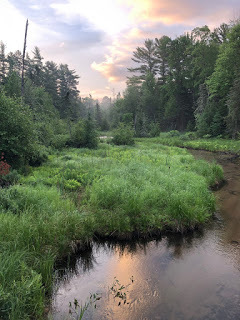
In my teen years, I would work and travel little.
It was mostly through books that I learned about the world. I wouldn’t see much of the United States until I’d be in my 20s.
But through the pages of my fiction and non-fiction and even textbooks, I learned much and dreamed a lot in those formative years. Writing also transported me. It took me to places I couldn’t access but still could feel in the corners of my imagination.
Writing and publishing brought me to new people and friends - all across the United States and even overseas - without spending as much as a tank of gas.
About two years ago, I left the county I spent most of my life in to move north. Until then, this was only an area I’d pass through or sometimes vacation in for a long weekend or so. I’d always wanted to live in the lake towns here. In many ways, it was a dream come true. In many other ways, it was terrifying.
I had to start my life over, mid-way through life, with nothing but a pile of books, pages of manuscripts of my own and my cat. I had no friends here, no roots.
As I prepare these last few weeks to move yet again - this time to a place I’ve only ever visited and never once dreamed of belonging in, I again find myself turning the pages of books and scribbling in my notebooks and laptop to process all the upcoming change. All the fear that comes with travel and the unknown.
Those pages are my one main constant. The books and my writing travels with me, no matter where I go. It IS my blood, my stability, my core, my soul. I also have my writing friends, because we have established true roots with each other as well. It is these things I rely on as I again hit the blacktop to start over once again.
The truth is, we never know if those miles will be the best of us or the worst of us. Had you told me two years ago how in love I’d become with this place - the towering pines, the sunsets across the lake, the mist off the creek in the morning, the towns firmly set 40 years behind the rest of the world, the friends I’ve made, the pages I’ve written, the words I’ve lost and gained - I’d never have believed it.
So I’ll pack a bag again. With those same books I’ve had since I was a kid. And a teen. And a young woman. With a few new ones I’ve gained here the last two years.
Who knows what words await me there?
Happy Reading!
AM Bostwick

Published on August 19, 2019 01:30
August 17, 2019
Traveling to Write Our Books
I don't travel to seek ideas for books: all my ideas come from my own ordinary life.
I don't travel to research my books: they all take place close to home.
But I adore traveling to write my books. That is to say, I adore writing in Other Places.
There is just something so magical and stimulating about writing Somewhere Else. I write more and better when I'm not lying on my couch at home. Or at least this is what I tell myself to give myself permission to arrange to write on the couches of my writer friends.
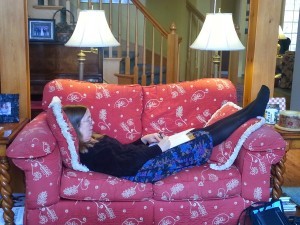 I love writing in cafes, preferably on a snowy day, sipping hot chocolate and nibbling on a pastry.
I love writing in cafes, preferably on a snowy day, sipping hot chocolate and nibbling on a pastry.
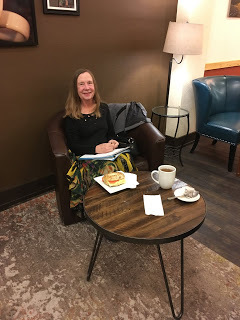 I've taken myself on the bus from Boulder to Denver to write in beautiful Union Station, preferably with a jaunty elf to keep me company.
I've taken myself on the bus from Boulder to Denver to write in beautiful Union Station, preferably with a jaunty elf to keep me company.
 There is no lovelier place to write than in the Denver Botanic Gardens.
There is no lovelier place to write than in the Denver Botanic Gardens.
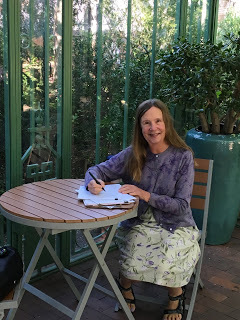 My favorite recent writing stint elsewhere was sitting cross-legged on the floor at the Denver Convention Center, when I was speaking there at this year's Pop Culture Con. I finished writing the last two chapters of my latest book under the gaze of a curious Big Blue Bear.
My favorite recent writing stint elsewhere was sitting cross-legged on the floor at the Denver Convention Center, when I was speaking there at this year's Pop Culture Con. I finished writing the last two chapters of my latest book under the gaze of a curious Big Blue Bear.
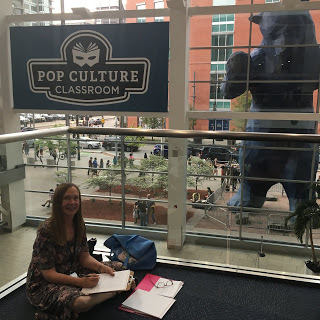 So if you're feeling stuck, or sad, or just in need of an extra jolt of joy in your writing life, go write somewhere else. Take yourself out on a writing date. All writers need writing treats!
So if you're feeling stuck, or sad, or just in need of an extra jolt of joy in your writing life, go write somewhere else. Take yourself out on a writing date. All writers need writing treats!
Oh, and here I am in my most exotic writing spot to date: seated on the Great Wall of China.
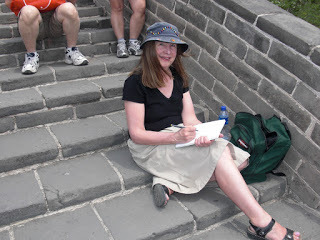 Who wants to come on a writing date with me?
Who wants to come on a writing date with me?
I don't travel to research my books: they all take place close to home.
But I adore traveling to write my books. That is to say, I adore writing in Other Places.
There is just something so magical and stimulating about writing Somewhere Else. I write more and better when I'm not lying on my couch at home. Or at least this is what I tell myself to give myself permission to arrange to write on the couches of my writer friends.
 I love writing in cafes, preferably on a snowy day, sipping hot chocolate and nibbling on a pastry.
I love writing in cafes, preferably on a snowy day, sipping hot chocolate and nibbling on a pastry. I've taken myself on the bus from Boulder to Denver to write in beautiful Union Station, preferably with a jaunty elf to keep me company.
I've taken myself on the bus from Boulder to Denver to write in beautiful Union Station, preferably with a jaunty elf to keep me company. There is no lovelier place to write than in the Denver Botanic Gardens.
There is no lovelier place to write than in the Denver Botanic Gardens.
 My favorite recent writing stint elsewhere was sitting cross-legged on the floor at the Denver Convention Center, when I was speaking there at this year's Pop Culture Con. I finished writing the last two chapters of my latest book under the gaze of a curious Big Blue Bear.
My favorite recent writing stint elsewhere was sitting cross-legged on the floor at the Denver Convention Center, when I was speaking there at this year's Pop Culture Con. I finished writing the last two chapters of my latest book under the gaze of a curious Big Blue Bear.
 So if you're feeling stuck, or sad, or just in need of an extra jolt of joy in your writing life, go write somewhere else. Take yourself out on a writing date. All writers need writing treats!
So if you're feeling stuck, or sad, or just in need of an extra jolt of joy in your writing life, go write somewhere else. Take yourself out on a writing date. All writers need writing treats!Oh, and here I am in my most exotic writing spot to date: seated on the Great Wall of China.

 Who wants to come on a writing date with me?
Who wants to come on a writing date with me?
Published on August 17, 2019 23:00
August 16, 2019
Traveling, Page by Page - By Michele Weber Hurwitz
I grew up in the late seventies in a middle class suburb of Chicago comprised of stay-at-home moms, ornery poodles, summer days at the public pool, bologna on white bread with red Kool-aid, and front seats of cars that were as long as a sofa. Looking back, it was a lovely, idyllic childhood. But when I was young, it was absolutely, positively boring. Nothing all that exciting ever happened, except the time my brother decided to moon the cantor at our synagogue. But that's another story.
I had to go somewhere to find excitement, and where I found it was in the pages of beloved books like Island of the Blue Dolphins by Scott O'Dell, Treasure Island by Robert Louis Stevenson, and Heidi by Johanna Spyri.
 Oh, to live on a remote island away from my annoying brothers! To fish for my dinner (even though I hated fish), and make my own shelter from palm leaves! To fend for myself and eat when I wanted, not be called down to the dinner table when my dad pulled up exactly at 5:30. To confront real danger!
Oh, to live on a remote island away from my annoying brothers! To fish for my dinner (even though I hated fish), and make my own shelter from palm leaves! To fend for myself and eat when I wanted, not be called down to the dinner table when my dad pulled up exactly at 5:30. To confront real danger!
Or to meet larger-than-life people named Billy Bones and Black Dog, not Mrs. Dietch at the end of the block who yelled at kids for stepping in her flower bed. To search for treasure with a real map where X marks the spot. To dig and dig, finally hit the chest with my shovel, and open it to find jewels and gold coins galore!
Honestly, I was convinced there was treasure buried in my backyard, or at least, an Indian arrowhead. Never did find either.
And to have a grandfather who lived on a mountain like Heidi's! Mine lived in a retirement home on a busy city street and got in line for dinner at 4 p.m.
I firmly believe that the stories we read when we're young stay with us long into adulthood and shape the people we become. I think those books I cherished planted in me the desire to (actually) travel and meet people who aren't part of my normal, every day life. This year, I took a hiking trip in Death Valley and a long weekend in sultry, mysterious Savannah. I didn't come across anyone named Black Dog but I'm still hoping.
 In between trips, I still travel on the page. I'm currently taking a break from reading middle grade and I'm deep into the Neapolitan novels by Elena Ferrente - immersive stories of the lives and friendship of two women in 1950s/1960s Naples, Italy. I feel like I'm there.
In between trips, I still travel on the page. I'm currently taking a break from reading middle grade and I'm deep into the Neapolitan novels by Elena Ferrente - immersive stories of the lives and friendship of two women in 1950s/1960s Naples, Italy. I feel like I'm there.
Find Michele online at micheleweberhurwitz.com. Her newest middle grade novel, set in a small Wisconsin town, is coming May 2020 from Wendy Lamb Books/Penguin Random House.
I had to go somewhere to find excitement, and where I found it was in the pages of beloved books like Island of the Blue Dolphins by Scott O'Dell, Treasure Island by Robert Louis Stevenson, and Heidi by Johanna Spyri.
 Oh, to live on a remote island away from my annoying brothers! To fish for my dinner (even though I hated fish), and make my own shelter from palm leaves! To fend for myself and eat when I wanted, not be called down to the dinner table when my dad pulled up exactly at 5:30. To confront real danger!
Oh, to live on a remote island away from my annoying brothers! To fish for my dinner (even though I hated fish), and make my own shelter from palm leaves! To fend for myself and eat when I wanted, not be called down to the dinner table when my dad pulled up exactly at 5:30. To confront real danger!Or to meet larger-than-life people named Billy Bones and Black Dog, not Mrs. Dietch at the end of the block who yelled at kids for stepping in her flower bed. To search for treasure with a real map where X marks the spot. To dig and dig, finally hit the chest with my shovel, and open it to find jewels and gold coins galore!
Honestly, I was convinced there was treasure buried in my backyard, or at least, an Indian arrowhead. Never did find either.
And to have a grandfather who lived on a mountain like Heidi's! Mine lived in a retirement home on a busy city street and got in line for dinner at 4 p.m.
I firmly believe that the stories we read when we're young stay with us long into adulthood and shape the people we become. I think those books I cherished planted in me the desire to (actually) travel and meet people who aren't part of my normal, every day life. This year, I took a hiking trip in Death Valley and a long weekend in sultry, mysterious Savannah. I didn't come across anyone named Black Dog but I'm still hoping.
 In between trips, I still travel on the page. I'm currently taking a break from reading middle grade and I'm deep into the Neapolitan novels by Elena Ferrente - immersive stories of the lives and friendship of two women in 1950s/1960s Naples, Italy. I feel like I'm there.
In between trips, I still travel on the page. I'm currently taking a break from reading middle grade and I'm deep into the Neapolitan novels by Elena Ferrente - immersive stories of the lives and friendship of two women in 1950s/1960s Naples, Italy. I feel like I'm there.Find Michele online at micheleweberhurwitz.com. Her newest middle grade novel, set in a small Wisconsin town, is coming May 2020 from Wendy Lamb Books/Penguin Random House.
Published on August 16, 2019 05:00



